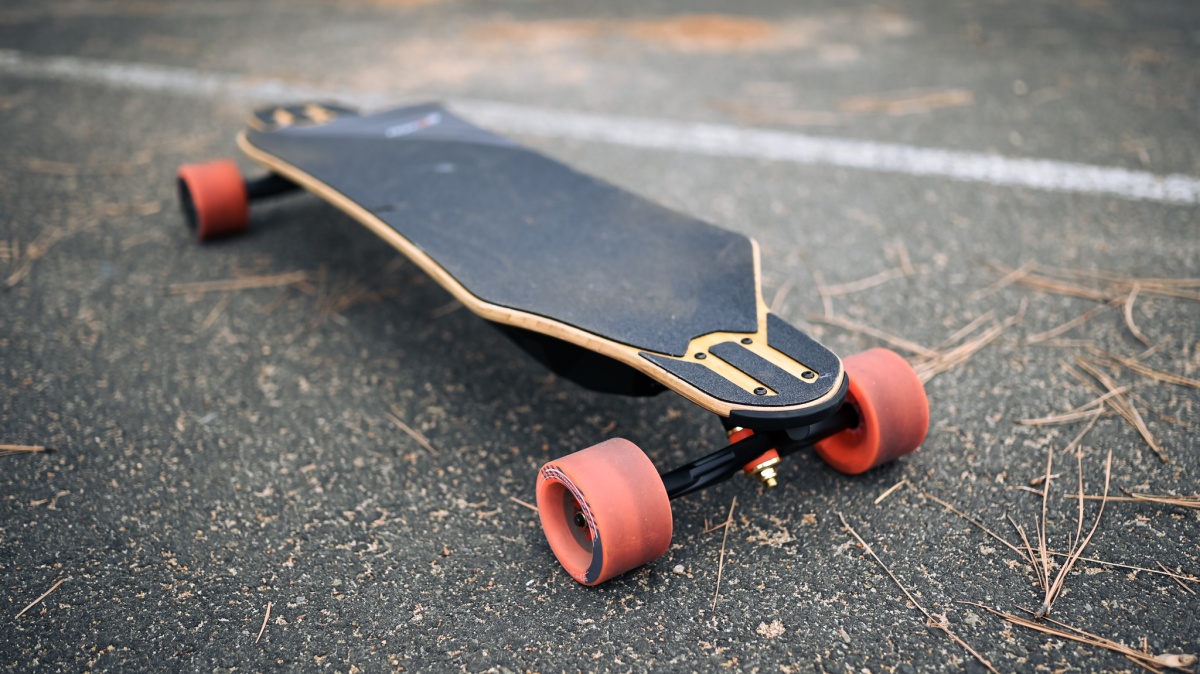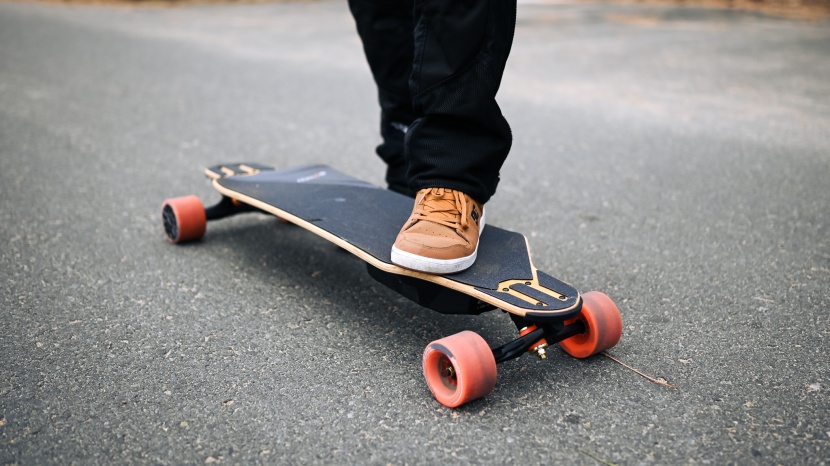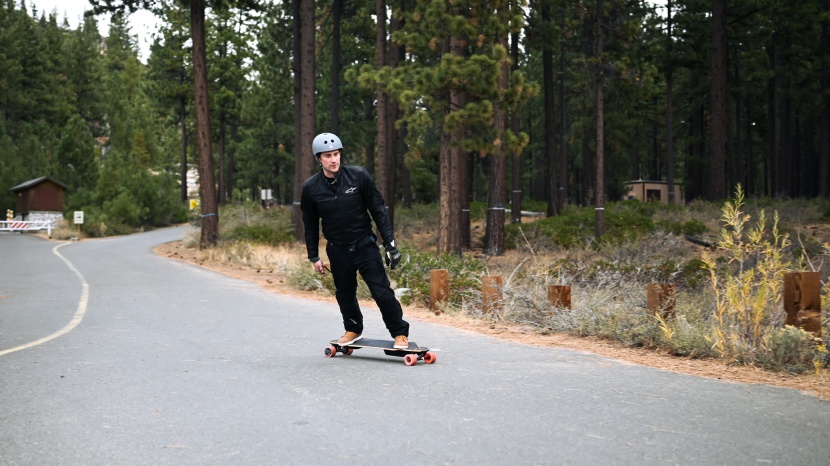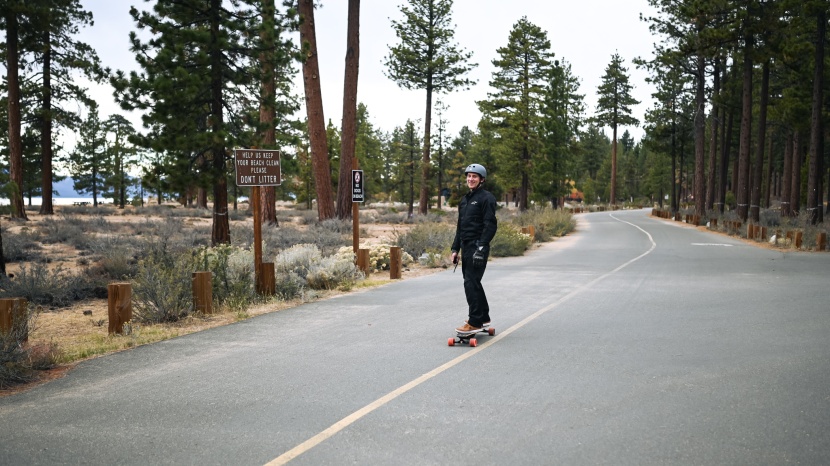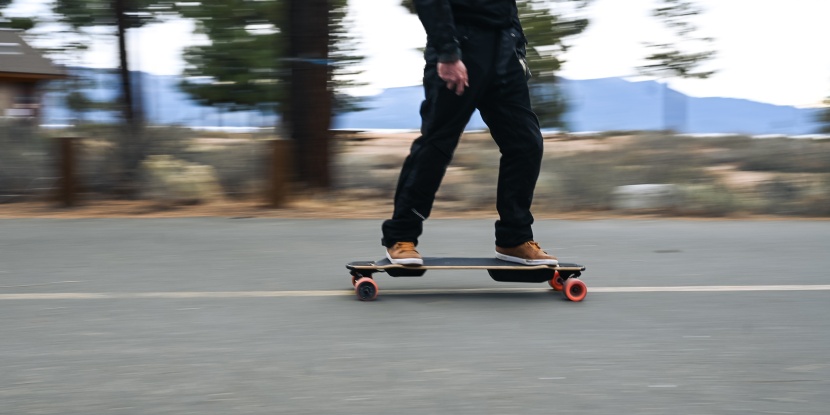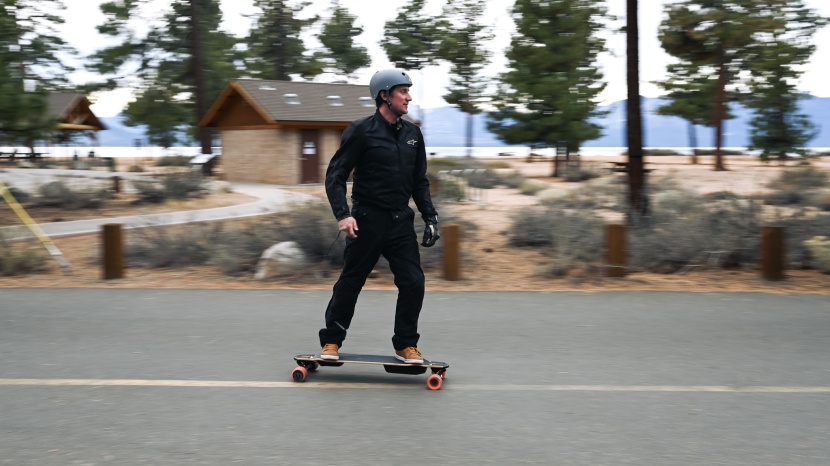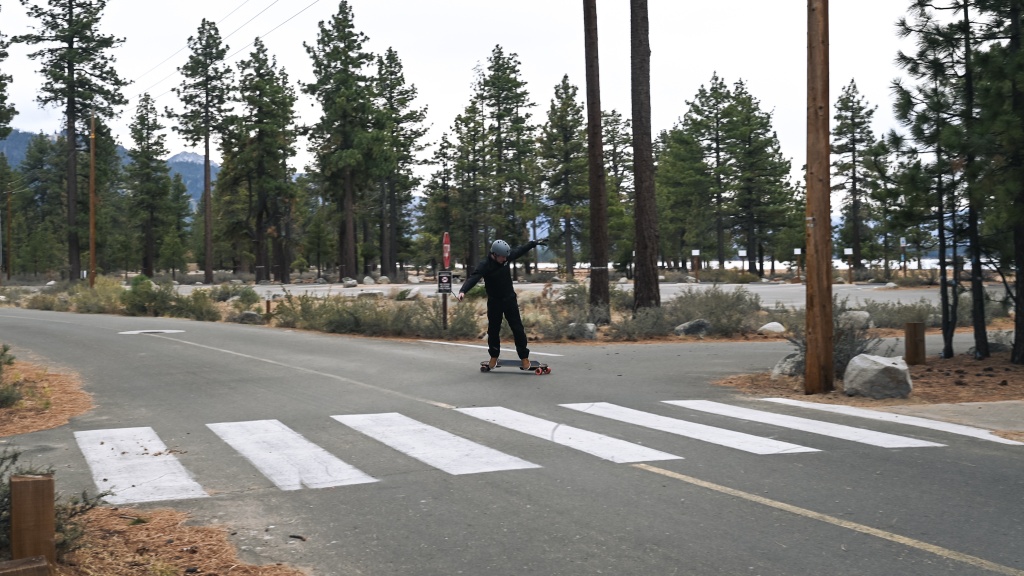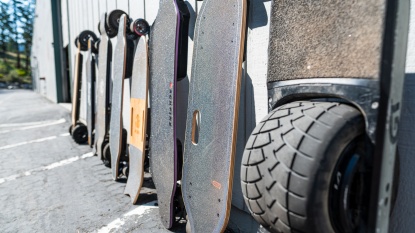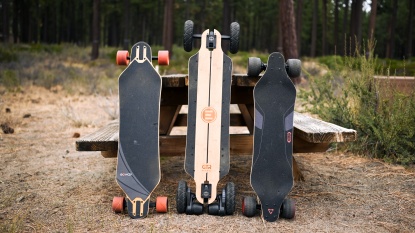Our Verdict
Compare to Similar Products
 This Product Exway Flex | |||||
|---|---|---|---|---|---|
| Awards | A Budget-Friendly Onewheel Option | Best Budget-Friendly All-Terrain Option | Best Budget-Friendly Option | ||
| Price | $699 List $749.00 at Amazon | $1,050 List | $999 List $699.00 at Amazon | $499 List | $429 List $349.00 at Amazon |
Overall Score  |
|||||
| Star Rating | |||||
| Bottom Line | A budget-friendly hub wheel board for new riders or those needing the most cost effective option available | If you want a board that can venture off the pavement, the Pint is the perfect choice | This all-terrain board with flatless tires delivers delivers an excellent ride for the price point | A fun, affordable ride for beginners who can start out slow but choose faster speeds with experience | Comfortable, fast, and tailored towards those who already know what they're doing, this board is a great budget options for experienced riders |
| Rating Categories | Exway Flex | Onewheel Pint | JKing Jupiter-01 Al... | Meepo V5 | Backfire G2 |
| Ride Comfort (30%) | |||||
| Range (20%) | |||||
| Braking (20%) | |||||
| Speed (10%) | |||||
| Hills (10%) | |||||
| Beginner Friendly (10%) | |||||
| Specifications | Exway Flex | Onewheel Pint | JKing Jupiter-01 Al... | Meepo V5 | Backfire G2 |
| Tested Maximum Range | 14.4 miles | 10.0 miles | 12.3 miles | 10.9 miles | 15.9 miles |
| Tested Maximum Speed | 23.9 mph | 14.2 mph | 25.5 mph | 24.6 mph | 23.5 mph |
| Tested Stopping Distance | 45 ft | 14 ft | 23 ft | 24 ft | 31 ft |
| Measured Weight | 18.4 lbs | 25.5 lbs | 23.2 lbs | 17.6 lbs | 17.8 lbs |
| Measured Time in Uphill Grade | 43 seconds | 32 seconds | 27 seconds | 58 seconds | 66 seconds |
| Measured Charge Time | 220 minutes | 114 minutes | 244 minutes | 180 minutes | 216 minutes |
| Measured Deck Length | 38.3" | 27" | 39.8" | 38" | 38.2" |
| Riding Modes | 1 2 3 4 |
Redwood Pacific Elevated Skyline |
1 2 3 4 |
Low Medium High Pro |
Eco Sport Turbo |
| Battery | 216Wh 18650 | Lithium Ion (NMC) | Lithium Ion | 10S2P 4Ah Lithium Ion | 42V 5.2Ah, 187Wh 10S2P Changhong Sunpower Cells |
| Manufacturer Weight Limit | 400 lbs | 250 lbs | 330 lbs | 330 lbs | 265 lbs |
| Manufacturer Deck Material | Flexible Tri-Laminate | Composite Material | 7 Ply Northeast Maple 2 Ply Canadian Maple 1 Ply Fiberglass |
8 Ply Canadian Maple | 8 Ply Canadian Maple |
| Wheel Size | 85 mm | 267 mm | 152 mm | 90 mm | 96 mm |
| Truck Width | 8" | N/A | 9" | 8" | 7" |
| App available | Yes | Yes | No | No | Yes |
| Lighting | No | Yes | Yes | No | No |
Our Analysis and Test Results
Ride Comfort
Your electric skateboard's comfort is crucial to your enjoyment of the sport, so we weighted this metric at 30% of the total score of the Flex. We tested this board's comfort by taking it on many rides, sometimes for miles. We put it through the paces on a variety of surfaces, from smooth pavement to cracked asphalt to bumpy trails, and took notes along the way. The Flex landed in the middle of the pack in this metric, with an excellent deck feel, but was a little bumpy on rougher terrain.
The concave shaping of the Flex cradled our feet comfily, keeping us on the board in any terrain. The padded grip tape is also a welcome addition on top of the flexible trilaminate deck material.
While small cracks were easily handled, we unfortunately felt every medium to large-sized crack or bump, and our feet even vibrated on rougher surfaces. Our testers all agreed this option is best on smoother riding surfaces, but the secure-feeling deck will help you stay on if your ride occasionally gets rougher.
Range
We love being able to go on longer rides, so we weighted the range of the Flex at 20% of its total score. We tested this board by charging the battery up to 100% and riding it for miles until it was completely dead, noting the total distance and any performance changes. We also recorded the time needed to recharge the battery back to full. The Flex doesn't score the highest in this metric, and we recommend other options if you want to take longer rides.
Our testers found that the Flex has a max range of 14 miles, which is half the distance of some boards. For many, this range will be fine for what they'd like to ride, with plenty of fun that can be had in that distance — just consider driving your car further before starting your ride. In the last mile or two of our max range test, the Flex slowed down slightly but otherwise offered consistent performance throughout its battery's life.
The Flex required 3 hours and 40 minutes to charge from 0% to 100% battery, making it one of the slower charging times relative to its range. While a few other options took longer to charge, their range was also substantially further. For many riders, this won't be a huge deal, but if you're looking to ride multiple times a day, you might need to keep your rides short if you choose this option.
Speed
The speed of the Flex was weighted at 10% of its total score. We created a set track, entered it going at full speed, recorded its time, and repeated this process three times to create an average top speed. We also measured this board's acceleration time from a standstill to the end of a 50-foot track, repeating this test three times to get an average. Speed is one of the highest scoring metrics for the Flex and greatly boosted its rankings amongst other boards we reviewed.
The top speed of this option clocked in at an average of 23.86 miles per hour, offering plenty of power for your riding wants. Relative to its ride comfort, we'd recommend keeping this board off of rougher surfaces if you're planning on taking the Flex to its top speed.
The Flex offers decent acceleration with an average of 4.18 seconds to get through our standardized 50-foot track. The best of the boards were only approximately one second faster, and those boards cost significantly more than the Flex.
Braking
Every rider must be able to stop, so we gave this metric 10% of the total score of the Flex. We tested this board by regulating speed going on a sustained downhill, noting how easily we could control our speed and how slow we could go. The Flex brakes were also tested by getting it up to 11-13 mph and slamming on the brakes, measuring the distance needed to come to a complete stop. This board's weakest metric is braking, but it still landed around the lower middle of the pack.
When traveling downhill, the Flex did a great job regulating its speed if we kept it below 10 mph. Regulating our speed was challenging once we got above 10 mph, with a slightly scary delay from the time we applied the brakes to the time we truly slowed down. As we learned the nuances of the Flex, we were able to anticipate our braking needs earlier, but we'd recommend that you take it slower on your descents.
The Flex landed in the middle of the pack in our stopping distance tests, with an average distance of 45 feet. Our best scoring options in this test boasted distances of 14 feet, with our worst scores coming in at 77 feet. If you demand aggressive, fast-acting brakes, we'd recommend another option, but the Flex remains worthy of your consideration.
Hills
Many electric skateboarders live or ride in hilly areas, so we dedicated 10% of the total score to this section of our assessment. We put the Flex through many hill climbs of varying steepnesses up to 14%-15% grades, taking notes and timing each uphill. We were impressed with the Flex in this metric, especially when considering its price point.
The Flex was able to zip up each hill we threw at it with a minimal decrease in speed. Even at steeper grades, we were pleased with this board's ability to get uphill with nearly the same amount of power we felt on flat ground.
Beginner Friendly
10% of the total score of this board is given to being beginner-friendly. We investigated this metric by examining the remote, beginner mode, and weight of the Flex to determine how amicable it is for those new to the sport. This board scored the highest of any option we tested, making it a top contender for anyone getting into electric skateboarding.
The Flex offers an easy-to-use remote with a simple button layout, allowing you to swiftly adjust key components of the board. An app also accompanies this option, allowing for further customization to fine-tune your ride just the way you want it.
Our favorite aspect of the Flex in this metric is its adjustable speed limit and its beginner mode. Even without speed limit tinkering, the beginner mode reduces the max speed down to 5-6 mph and has slow, steady acceleration. The braking isn't jerky, even if you accidentally hammer the brakes, greatly reducing the likelihood of getting thrown off.
This option is one of the lightest boards in our review at a measured weight of 18.4 pounds, making it far easier to transport than most of the competition.
Should You Buy the Exway Flex?
If you're tight on cash or are looking for the best beginner option, the Exway Flex should live at the top of your list.While there are some so-so performance considerations, the Flex is a functional and capable board that's half or a third of the price of our highest-scoring options. Rest easy knowing that we've put in the leg work testing this board, unearthing its best and worst qualities.
What Other Electric Skateboards Should You Consider?
The Flex is perfect for those who are new to electric skateboarding or are shopping on a budget. For a few hundred more dollars, the Backfire Zealot S checks all the boxes of a high-performance ESB, but is still reasonably priced. If you're looking for a top-tier ride and you don't mind spending the extra cash, the Ownboard Carbon Zeus Pro is ridiculously fast with a huge range. If you're in the market for a monowheel model, the Onewheel GT is unbeatable while the smaller Onewheel Pint offers solid overall performance at a much smaller price.


